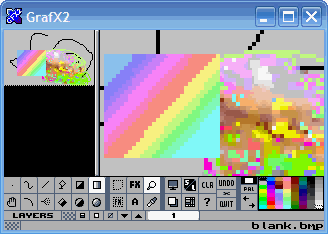Color cycling is powered by changing specific colors in a color palette that gives the illusion of animation. [3] To quote Mark Ferrari:
At the simplest, most basic level, color cycling creates the illusion of animated movement in pretty much the same way light bulbs on a theater marquee do.
When the light bulbs on a theater marquee flash off and on in the right sequence it LOOKS like little dashes of light are chasing one another around the perimeter of the sign. But, as we all know, the individual light bulbs are not moving - only turning off and on in a coordinated sequence that creates the illusion of movement. In color cycling, each affected pixel on screen is holding completely still, like those marquee light bulbs, but changing colors in a looping sequence - which, in coordination with all the adjacent pixels changing colors in their own offset sequences creates the illusion of moving bands of color.

